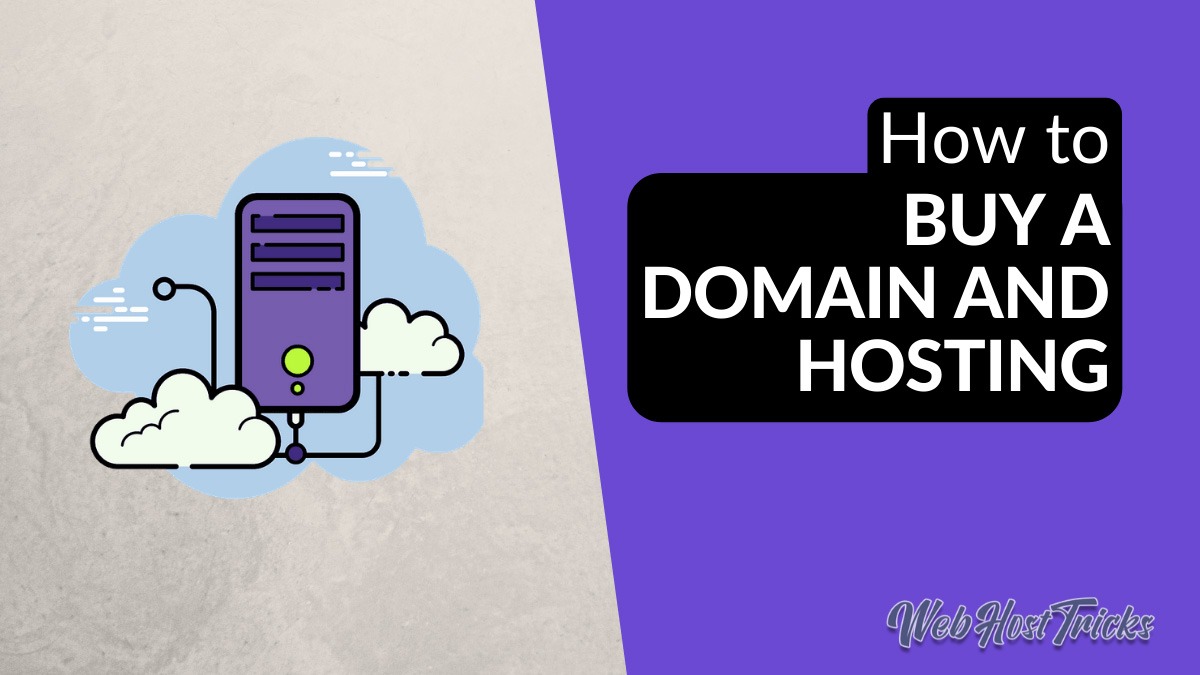Buy domain hosting and unlock your online potential. This essential step in building a website allows you to claim your unique corner of the internet, giving you a platform to share your ideas, connect with audiences, and grow your business. From understanding domain names and web hosting basics to choosing the right provider and securing your online presence, this guide will walk you through the entire process.
Whether you’re launching a blog, showcasing your portfolio, or starting an e-commerce store, owning a domain name and hosting your website are crucial. It’s like owning a physical address for your online presence, allowing visitors to easily find and access your content.
Understanding Domain Names: Buy Domain Hosting

A domain name serves as your website’s unique address on the internet, making it easily accessible to users. It acts as a bridge between human-readable text and the numerical IP addresses that computers use to communicate. Think of it like a street address for your online home.
Types of Domain Names
Domain names come in various formats, each with a specific purpose and connotation. The part following the dot (.) indicates the top-level domain (TLD), which provides information about the website’s nature.
- .com: The most common TLD, generally associated with commercial websites.
- .org: Often used by non-profit organizations, educational institutions, and community groups.
- .net: Typically used by network service providers or companies involved in internet infrastructure.
- .gov: Exclusively reserved for government agencies and institutions.
- .edu: Used by educational institutions, such as schools, colleges, and universities.
Registering a Domain Name
The process of registering a domain name involves several steps:
- Choose a domain name: Select a name that is relevant to your website’s content and easy to remember.
- Check availability: Use a domain registrar’s website to verify if the desired name is available.
- Select a registrar: Choose a reputable domain registrar, like GoDaddy, Namecheap, or Google Domains.
- Complete the registration: Provide your personal information and payment details to secure the domain name.
- Set up DNS records: Configure DNS settings to point your domain name to your website’s hosting server.
Web Hosting Basics
Imagine you’ve built a beautiful house, but it’s sitting in the middle of nowhere with no address. No one can find it! Web hosting is like the address for your website. It’s the space on a server where your website files live, allowing visitors to access your online content.
Types of Web Hosting
Web hosting comes in different flavors, each with its own set of features and benefits. Understanding these options helps you choose the best fit for your website’s needs and budget.
- Shared Hosting: Think of shared hosting as a multi-family apartment building. Multiple websites share the same server resources, making it the most affordable option. However, performance can be affected if one website experiences heavy traffic. Shared hosting is suitable for small, low-traffic websites like personal blogs or simple online portfolios.
- VPS Hosting: VPS hosting is like renting a private apartment in a building. You have dedicated resources, offering better performance and security than shared hosting. VPS hosting is a good choice for growing websites or those requiring more control over server settings.
- Dedicated Hosting: This is like owning your own house. You get the entire server for your website, providing maximum performance, security, and flexibility. Dedicated hosting is ideal for high-traffic websites, e-commerce platforms, or businesses requiring complete control over their server environment.
Comparing Hosting Types
| Feature | Shared Hosting | VPS Hosting | Dedicated Hosting |
|---|---|---|---|
| Cost | Most affordable | More expensive than shared | Most expensive |
| Performance | Can be slow if other websites on the server are experiencing heavy traffic | Faster than shared hosting | Fastest performance |
| Security | Less secure than other options | More secure than shared hosting | Most secure |
| Control | Limited control over server settings | More control over server settings | Complete control over server settings |
| Scalability | Limited scalability | More scalable than shared hosting | Highly scalable |
Managing Your Domain Name and Hosting

Now that you’ve secured your domain name and web hosting, let’s dive into managing them effectively. This section covers essential aspects like domain name settings, website performance monitoring, and troubleshooting common issues.
Domain Name Settings Management
Managing your domain name settings is crucial for ensuring smooth website operation and control over your online presence. Here’s a step-by-step guide:
- Renewal: Regularly check your domain name’s expiration date and renew it well in advance to prevent your website from going offline. Most registrars offer automatic renewal options for convenience.
- Transfer: If you decide to switch registrars, you can transfer your domain name. The process typically involves transferring the ownership to the new registrar and updating the DNS settings.
- DNS Management: Domain Name System (DNS) settings control how your website is accessed. You can manage these settings through your domain registrar’s control panel.
DNS Management
- Understanding DNS Records: DNS records link your domain name to your website’s server. The most common types include:
- A record: Maps your domain name to your server’s IP address.
- CNAME record: Creates an alias for your domain name, pointing to another domain name.
- MX record: Specifies the mail server responsible for handling email for your domain.
- Updating DNS Settings: Changes to DNS settings can take up to 48 hours to propagate globally.
- Using a DNS Management Tool: Consider using a DNS management tool for advanced features like DNS analytics and security.
Website Performance Monitoring
Monitoring your website’s performance is essential for identifying and resolving issues promptly.
- Website Speed: A slow website can negatively impact user experience and search engine rankings. Tools like Google PageSpeed Insights and Pingdom can help you analyze your website’s speed.
- Uptime: Website uptime refers to the percentage of time your website is accessible. Monitoring uptime ensures that your website is available to visitors.
- Security: Regularly scan your website for vulnerabilities and ensure that security measures are in place to protect your website and visitors’ data.
Troubleshooting Common Issues
Encountering website issues is common, but effective troubleshooting can help you resolve them quickly.
- DNS Errors: Ensure your DNS settings are correct and properly configured.
- Server Errors: Contact your web hosting provider if you encounter server-related errors.
- Website Downtime: Investigate the cause of downtime and take steps to prevent it from recurring.
Benefits of Using a Domain Name Registrar and Web Hosting Control Panel
- Domain Name Registrar: A domain name registrar provides a platform for registering and managing your domain names. They offer features like DNS management, domain renewal, and domain transfer.
- Web Hosting Control Panel: A web hosting control panel allows you to manage your web hosting account, including website files, email accounts, databases, and security settings. Popular control panels include cPanel and Plesk.
Domain Name and Hosting for Different Website Types

Choosing the right domain name and hosting plan depends on your website’s specific needs and goals. Different website types have unique requirements that influence the best domain name and hosting choices. This section explores the considerations for various website types, including e-commerce websites, blogs, and portfolio websites.
E-Commerce Websites
E-commerce websites require a domain name that reflects the brand and product offerings. Choosing a memorable and relevant domain name is crucial for attracting customers and building brand recognition. For example, a clothing store might choose a domain name like “stylehaven.com” or “fashionfinds.com.”
Hosting for e-commerce websites requires robust performance and security features. Choosing a hosting plan with enough storage space, bandwidth, and security measures is essential for handling online transactions and customer data.
Here are some key considerations for e-commerce websites:
* Domain Name:
* Short and memorable: Easy to remember and type.
* Relevant to the product or service: Reflects the business’s core offerings.
* Brandable: Unique and memorable.
* Hosting:
* Scalability: Ability to handle increased traffic and data storage as the business grows.
* Security: Measures like SSL certificates and firewalls to protect customer data and transactions.
* Performance: Fast loading speeds and reliable uptime for a positive user experience.
Blogs
Blogs typically focus on sharing content, information, and perspectives. Domain names for blogs should be relevant to the blog’s niche or topic. For example, a food blog might choose a domain name like “foodiedelights.com” or “culinaryadventures.com.”
Hosting for blogs is typically less demanding than e-commerce websites. Shared hosting plans often suffice for blogs with moderate traffic. However, as a blog grows, upgrading to a more robust plan, such as a VPS or dedicated server, might be necessary.
Here are some key considerations for blogs:
* Domain Name:
* Relevant to the blog’s niche: Reflects the blog’s content and target audience.
* Easy to pronounce and remember: Helps with discoverability and sharing.
* Unique and memorable: Sets the blog apart from competitors.
* Hosting:
* Performance: Fast loading speeds are essential for user engagement.
* Security: Basic security measures to protect the blog from malware and attacks.
* Scalability: Ability to handle increased traffic as the blog grows.
Portfolio Websites, Buy domain hosting
Portfolio websites showcase individuals’ or businesses’ work and achievements. Domain names for portfolio websites should be simple, professional, and reflect the individual’s or business’s brand. For example, a graphic designer might choose a domain name like “designby[name].com” or “[name]portfolio.com.”
Hosting for portfolio websites typically requires minimal resources. Shared hosting plans are often sufficient for static websites with minimal content. However, if the portfolio includes interactive elements or requires high-performance features, a more robust hosting plan might be necessary.
Here are some key considerations for portfolio websites:
* Domain Name:
* Professional and memorable: Reflects the individual’s or business’s brand.
* Simple and easy to understand: Clearly communicates the purpose of the website.
* Unique and relevant: Sets the portfolio apart from competitors.
* Hosting:
* Performance: Fast loading speeds are essential for a positive user experience.
* Security: Basic security measures to protect the website from attacks.
* Scalability: Ability to handle increased traffic if the portfolio gains popularity.
Final Summary
In today’s digital landscape, having a website is essential for success. By understanding the process of buying domain hosting, you can establish a strong online presence and reach your target audience effectively. From choosing the right domain name to securing your website, the steps Artikeld in this guide will help you build a robust and reliable online platform. Remember, your website is your digital home, so invest wisely and create a space that reflects your brand and resonates with your visitors.




